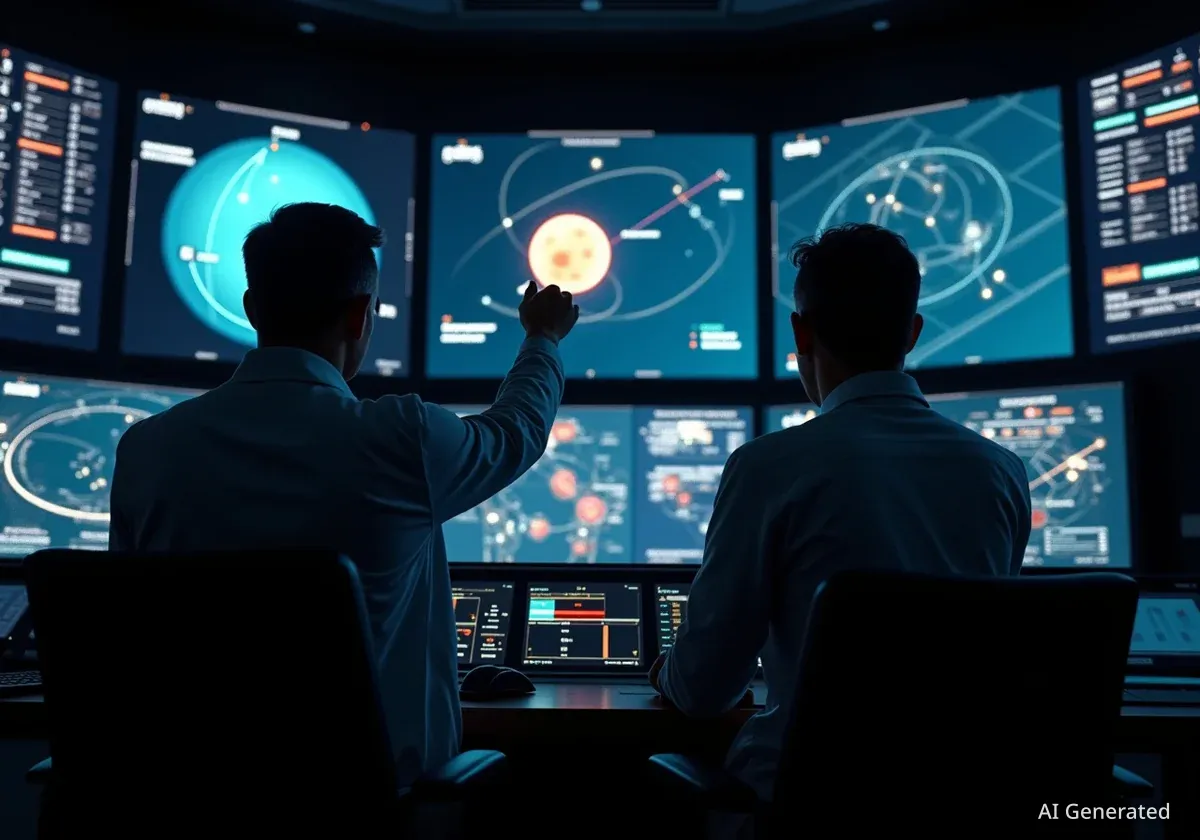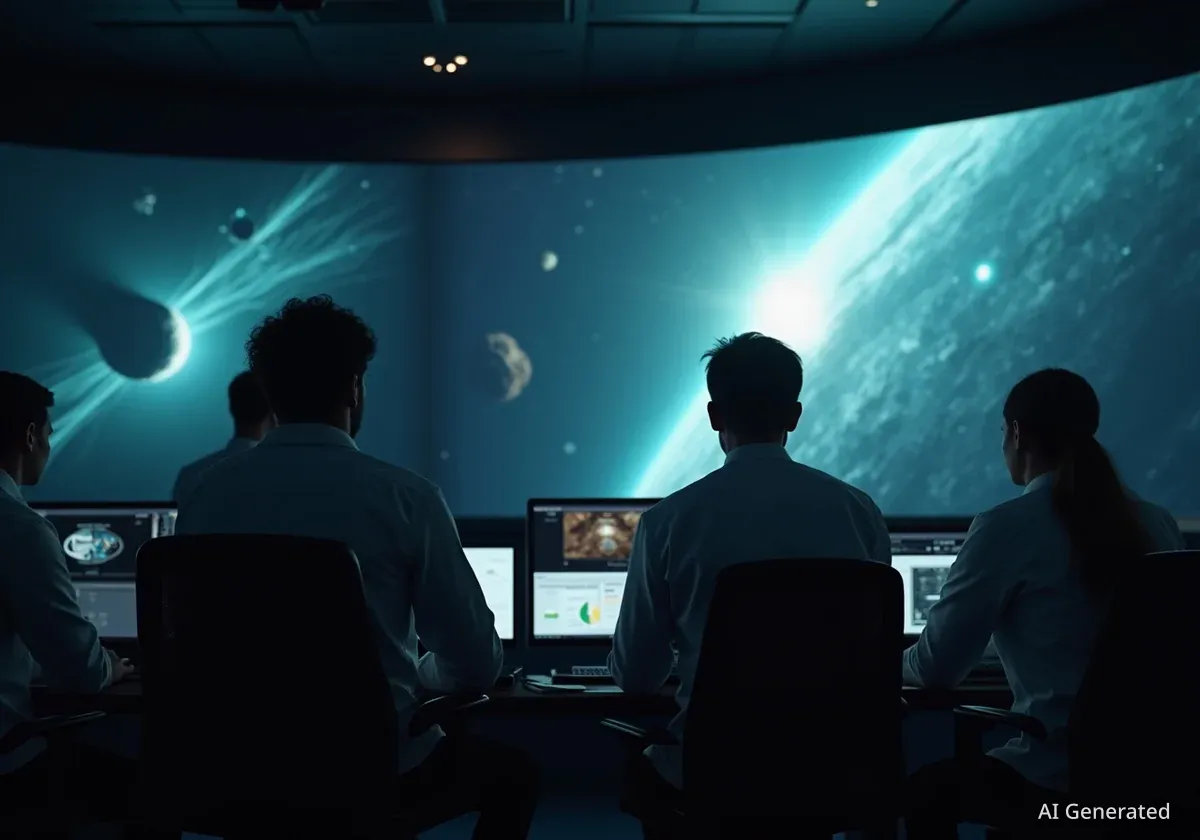An asteroid designated 2024 YR4 has a 4.3% probability of colliding with the Moon in 2032, according to recent calculations. A new scientific paper, which has not yet been peer-reviewed, explores potential actions to prevent the impact, which could generate a significant debris field threatening spacecraft and astronauts in low-Earth orbit.
Key Takeaways
- Asteroid 2024 YR4, measuring up to 220 feet in diameter, has an estimated 4.3% chance of hitting the Moon in 2032.
- A scientific paper outlines two main strategies: destroying the asteroid with a nuclear device or deflecting its trajectory.
- The primary concern is that a lunar impact could create a debris cloud in low-Earth orbit up to 1,000 times denser than normal levels.
- NASA has no current plans to intervene but will observe the asteroid with the James Webb Space Telescope to refine its orbital path and impact probability.
A Potential Threat to Earth Orbit
A recent paper uploaded to the preprint server arXiv by a team of more than a dozen researchers, including several NASA scientists, has brought attention to asteroid 2024 YR4. The asteroid was first identified in December by the Asteroid Terrestrial-impact Last Alert System (ATLAS) station in Chile.
While an earlier assessment suggested a small chance of the asteroid hitting Earth, further observations have since ruled out that possibility. However, the focus has now shifted to a potential lunar collision. The paper warns that such an event could have serious consequences for activities in orbit around our planet.
According to the authors, an impact could eject a massive amount of lunar material into space. This could increase the density of debris in low-Earth orbit by up to 1,000 times above normal levels for several days, posing a significant risk to satellites and human spaceflight missions.
About Asteroid 2024 YR4
NASA estimates the asteroid's size to be up to 220 feet (approximately 67 meters) across. Due to its size, it would be classified as a "city killer" if it were on a collision course with Earth, capable of causing severe damage to a metropolitan area.
Two Proposed Planetary Defense Strategies
The research paper evaluates two distinct approaches to mitigate the threat posed by 2024 YR4. Both options present significant technical challenges and depend on gathering more data about the asteroid itself.
Option 1: Robust Disruption
The first and more aggressive strategy involves what the paper calls a "robust disruption." This would entail using a nuclear explosive device to completely destroy the asteroid before it reaches the Moon. The goal would be to obliterate the space rock, preventing it from creating a concentrated debris field upon impact.
However, this method is entirely theoretical and has never been tested. A critical unknown is the asteroid's mass. Without precise knowledge of its composition and mass, a nuclear detonation might only fracture the asteroid into smaller pieces, potentially creating an even more unpredictable debris problem.
"If the explosion is not enough, you’re just going to create a debris field anyway," stated Julie Brisset, interim director of the Florida Space Institute, who was not involved with the paper.
Option 2: Kinetic Impactor Deflection
A less extreme alternative is to deflect the asteroid, nudging it onto a different trajectory that would miss the Moon. This approach has a proven precedent. In 2022, NASA's Double Asteroid Redirection Test (DART) mission successfully demonstrated this technique.
The DART spacecraft intentionally crashed into the small asteroid Dimorphos, altering its orbit. NASA confirmed the mission shortened Dimorphos's orbit by 33 minutes. Applying this method to 2024 YR4 would also require precise information about its mass to calculate the necessary force for a successful deflection.
NASA's DART Mission Success
- Target: Asteroid Dimorphos, orbiting a larger asteroid named Didymos.
- Date: September 26, 2022.
- Outcome: The impact successfully altered Dimorphos's orbital period, proving the kinetic impactor method is a viable planetary defense strategy.
NASA's Current Position and Future Observations
Despite the scenarios outlined in the paper, NASA has clarified that there are currently no active plans to interfere with asteroid 2024 YR4. In a statement, Kelly Fast, the agency’s acting planetary defense officer, confirmed that the immediate priority is observation, not intervention.
The agency plans to use the powerful James Webb Space Telescope to study the asteroid early next year. These observations are expected to provide much more accurate data on its physical properties and, most importantly, its orbital path.
"If observed, the additional data could improve our knowledge of where the asteroid will be in December 2032," Fast said. She added that the new information "could drop the impact probability to 0%."
Geopolitical and International Considerations
Even if a mission were deemed necessary, it would involve complex international and political challenges. The use of a nuclear device in space, in particular, would be a highly sensitive issue requiring extensive diplomatic negotiation.
The growing number of nations with ambitions for lunar exploration adds another layer of complexity. China has stated its goal to land astronauts on the Moon by 2030 and is collaborating with Russia on a potential lunar base. The United States is also actively pursuing lunar missions through its Artemis program.
Any mission to intercept an asteroid near the Moon would likely require cooperation between major spacefaring nations. Julie Brisset noted the political difficulties involved: "It would probably be countries that have the technical capability to do it, which maybe narrows it down to three or four, but would they want to work together?" The decision-making process for such an unprecedented planetary defense action would be as challenging as the technical execution.





